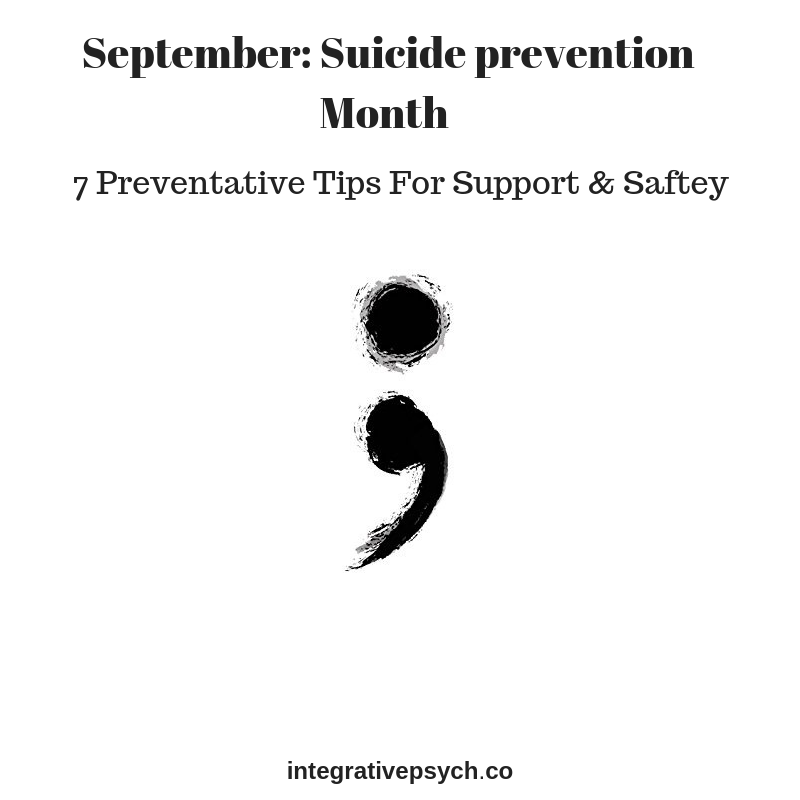Suicide Awareness Month-7 Tips
Have you ever seen someone walking around with a semicolon tattoo? Did you know what the tattoo stood for, what it represented, and what it meant?
Well let me tell you. The person you saw, engaged with or were curious about is someone who has a story to tell. A story with or without words. What matters is that the person has a story with a genre that belongs in the “bravery” section. They may have a story of pain that’s been slowly transforming to hope and healing.
The semicolon they wear, with pride, represents the making of a choice. A choice to stay alive, a choice to keep living. A choice to keep going with the pain of mental health, trauma or suicidal thoughts. Project Semicolon is a movement that encourages those who have anxiety, depression, who have self harmed or attempted suicide to draw a semicolon on their wrist.
Why Semicolon?
The semicolon is a symbol of hope for people with mental illness. A semicolon represents sentence the author could have ended, but chose not to. A choice you could have made but chose otherwise.
The Semicolon Movement has spread so that not only do those suffering with mental health issues wear the semicolon symbol tattooed, but many others who are in support of those struggling with mental health issues have decided to “encode” the symbol on their arms as well. The message is “We are here for you. We support you. Keep strong”. How powerful that society is taking a stance to reducing stigma and encouraging support to those in pain!
September is Suicide Awareness month, which is specifically targeted to raising awareness and offering support to those in pain. According to US Department for Health and Human Services, suicide is the 10th leading cause of death in the United States, and the rates are on the rise. In the United States, approximately 40,000 people commit suicide every year, a 24% rise compared to suicide rates in 1999 (Curtin, Warner & Hedegaard, 2016).
These numbers are frighteningly high. So what can you do? If you have a loved one who may be struggling with mental health or suicidal thoughts or tendencies, here are some 7 preventative tips for safety!
7 Tips for Prevention and Safety:
Inquire: Be curious and open. Ask you loved one about how they’re doing. Check in to be sure you are asking from a place of care and gentleness. You can say something like “ You mean a lot to me and I am worried about you. Have you been thinking of hurting yourself or thinking about taking your life?”. According to the National Institute for Mental Health (NIMH, 2015), asking someone about their suicidal thoughts does not increase the risks of suicide. It does the opposite by offering support and a space to think of other options, especially with someone who shows care.
Safety: First things first, you want to ensure your friend or loved one is safe. Ask if they have any forms of self harm or methods of killing themselves such as a bottle of pills, a weapon or lethal items within their reach. If they confide in you that they do, work with them to find a way to put them out of reach or even get rid of them.
Consistency: Be there fully. Don’t be “wishy woshy” and in-and-out. Your stability and consistency provides real support that lets them know you are there to listen and support and expresses your love for them. Let them see by your actions how much they do matter.
Resources: Help them find a mental health practitioner who can help them get through now and be of support for the longer term. Find a therapist via searching on psychologytoday.com or SAMHSA.
Create a Plan: Think creatively about alternative coping methods that your loved one can do when feeling distressed. According to research, when you have a plan ahead of coping skills, alternative choice points and supports in place, they serve as “speed bumps” to slow down the decision making process of taking ones life. You can print out a paper of “things to do when in distress” and add a few activities as well as people to reach out to. Dr. Marcia Linehan encourages creating a Sensory Bucket of things to do to help calm down. You can include scented candles, a favorite poem, essential oils, a warm fuzzy blanket and a playlist of favorite music (Linehan, 2015).
National Suicide Prevention Hotline 1-800-273-8255. Give this to your friend, or with permission, add this number to your friends phone. This hotline is available 24/7 where there are trained crisis workers on the other line. A note on this: if your friend is in a potentially life-threatening situation, call 911 or go to your local hospital or emergency room immediately.
Stay In Touch. Even after you connect your friend with a therapist or with help, stay in touch. Follow up with them and let them know you’re thinking of them and are sending strength their way. Staying in touch with someone who is thinking of suicide has proven to reduce the risks of committing suicide.
***
Last pointer: Keep yourself in Check: It’s your jobs to firstly, be attuned to yourself. Be sure that you are caring for your own mental health and ensuring that you are feeling steady inside. It’s important to be a support to others, but your health is primary. If you realize you’ve been struggling, there is no shame in reaching out. It takes courage and strength to ask for support. Sometimes being strong feels hard. Don’t do it alone. It’s ok to be there for loved ones, but be there for you as well!
Sources:
Curtin, S. C., Warner, M., and Hedegaard, H. (2016). Suicide rates for females and males by race and ethnicity: United States, 1999 and 2014. NCHS Health E-Stat. National Center for Health Statistics.
Linehan, M (2015): DBT® Skills Training Manual, Second Edition Second Edition: DBT Skills Training Handouts and Worksheets, Second Edition.
US Department for Health and Human Services. Center for Disease Control and Prevention. (2015). Suicide: At a Glance.




